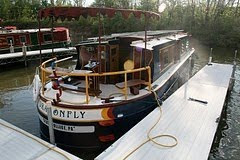We locked through Champlain Canal Lock 2, turned a corner, and easy as that, we were back on the Erie Canal, our home waters. From here on out we'll be traveling the same waters we boated in spring of 2011, homeward bound from our Great Loop trip.
Seems a good time to reflect on all the different canals we've cruised this summer.
The Rideau Canal
- Completed in 1832
- Runs from Kingston, on Lake Ontario, north to Ottawa
- 125 miles long (only 12 miles of this is manmade "cuts," the rest is natural rivers and lakes)
- 45 locks, most operated by hand using the original machinery

They were avoiding the border with that upstart new country, the United States of America, which (the British thought) might attack their vessels.
The canal's
defensive blockhouses (left) never had to fend off American attackers.
Today the Rideau is mainly used by American boaters, invading for their summer vacations.
Carillon Canal
 |
| A "guillotine gate" hangs over the massive lock |
- Completed in 1833, then enlarged in the late 1800s and again in the mid 1900s
- Located between Ottawa and Montreal
- Had 11 locks (each with small lifts) originally.
- One HUGE ultramodern lock today (right) with a 65-foot lift, next to a hydro dam
- Lets boats bypass big rapids on the Ottawa River
The Carillon was also originally intended for military travel. Later enlargements allowed it to handle commercial traffic, mostly barges carrying logs at first.
St. Anne deBellevue Canal
- Completed 1843, replaced a private canal built 1816
- Located on the West Island of Montreal, at the mouth of the Ottawa River
- Multiple locks originally, today one modern lock with a very small lift
Notice the date. What a difference a decade makes! This canal was opened just ten years after the Rideau, with the goal only of serving commercial traffic, not for defensive purposes. Today it's used only by pleasure craft and the canal waterfront anchors a street lined with lively restaurants and ice cream stands.
Lachine Canal
- Opened in 1825 (before the Rideau!)
- Runs through the southwest part of the Island of Montreal
- 9 miles long with (today) 5 locks
 |
| Low bridges on the Lachine! We lowered our canopy to sneak under |
This canal has always been used for commercial purposes. It let boats avoid the "treacherous" Lachine rapids, allowing easy passage from Ottawa and Montreal to the St Lawrence River and east to the ocean.
If the large number of construction cranes and rehabbing factories we saw on the banks are any indication, the canal is about to see a gentrification boom, with the lure of waterfront real estate.
Chambly Canal
- Completed in 1843, same year as the St. Anne de Bellevue
- Locks are on the Richelieu River, 77 miles long
- Runs from the town of Sorel (on the St. Lawrence River east of Montreal) south toward Lake Champlain
- 9 locks and 10 bridges (eight of which are still operated by hand with the original machinery or replicas)
 |
| Turbulence in the Chambly Locks! |
Forget about repelling those annoying Americans! After these two canals opened, trade between the nations exploded. All those sweet little French Canadian farms in the Richlieu River valley could ship produce and goods to New York City.
Today, plied only by us pleasure craft.
So there you have it: A fabulous tour of early Canadian history in 62 locks.
Hats off to Parks Canada, which operates and maintains these locks. They're parklike, well run, and the locktenders are friendly, helpful, and knowledgeable. The Rideau and Chambly Locks in particular are a living history museum, almost unchanged since they were first built.
Get yourself a pleasure craft and try it sometime. (We recommend the model called "LockMaster."
Saint-Ours Canal
- Completed in 1849
- A single modern lock today. Sometimes called the 10th lock on the Chambly
- Bypasses the final obstacle to navigation between the Saint Lwarence River and Lake Champlain
So there you have it: A fabulous tour of early Canadian history in 62 locks.
Hats off to Parks Canada, which operates and maintains these locks. They're parklike, well run, and the locktenders are friendly, helpful, and knowledgeable. The Rideau and Chambly Locks in particular are a living history museum, almost unchanged since they were first built.
Get yourself a pleasure craft and try it sometime. (We recommend the model called "LockMaster."







No comments:
Post a Comment